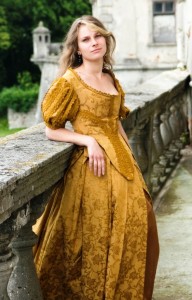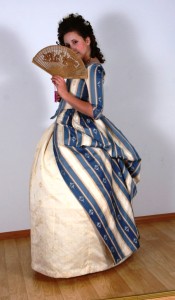XVII–XVIII ст. Europe - day "gallant century". Absolutism, especially in France, creates special forms of court ritual, tseremonialnist, worship etiquette, gallantry (celebration, splendor). They are spreading in various areas of life, including the relationship between man and woman - defiantly respect for women. This is fashion, a symbol of good taste, and this style is cultivated in various circles of the nobility and the bourgeoisie: gallantry should be considered as "characteristic of the era".
This time is called the "classical age woman" - it sets the tone, prevails in all areas of culture, composed around a cult.
 Shapes and sizes of contemporary costume change depending on the whims of fashion and Moments. Its symbolic meaning acquire color, Jewelry and Accessories, they are a kind of tool of gallant dialogue. So, eg, Suit XVII century. characteristic splendor, paradnist, Majesty, Soft plastic, three-dimensional shape. Fabrics decorated with ornate floral motifs, gerbami, crowns, vases. Kolirna bright gamma, saturated, often contrast: there are blue, red, white, black color.
Shapes and sizes of contemporary costume change depending on the whims of fashion and Moments. Its symbolic meaning acquire color, Jewelry and Accessories, they are a kind of tool of gallant dialogue. So, eg, Suit XVII century. characteristic splendor, paradnist, Majesty, Soft plastic, three-dimensional shape. Fabrics decorated with ornate floral motifs, gerbami, crowns, vases. Kolirna bright gamma, saturated, often contrast: there are blue, red, white, black color.
XVII ст. - A Baroque, where relief "molded" shape is achieved by the use of the tissue: frill, flounces, bunches of ribbons, bows. They could decorate any part of the costume, until the gloves, pants, shoes.
Expansion of baroque splendor could not stop even many laws against luxury. They not only forbade commoners, but the nobility to use gold and silver finish, fabric with gold thread, import stockings, lace and other luxury items. As a result of these measures, the main and often the only decoration costume are tape, and the more and more abundant ones they are used.
Throughout the XVII century. wearing a corset, form which repeatedly changes. In the first half of the century it short, dominant line of costume - horizontal shoulder girdle. Bulk, balonoobrazni sleeves and skirts give the impression of a large, full figure. Floor dresses worn another, top dress - Swing роб, sealed to the zipper or lace corsages.
 With the other half of the seventeenth century. suit loses its splendor. Corset becomes elongated, lifting the chest and severely tightening the waist (Sul 40 see!), line of which slightly underestimated. Hose narrowed and become shorter (to the elbow), and bottom decorated with lace ruffles. It seems "narrow", graceful figure. The peculiarity of dress - cleavage.
With the other half of the seventeenth century. suit loses its splendor. Corset becomes elongated, lifting the chest and severely tightening the waist (Sul 40 see!), line of which slightly underestimated. Hose narrowed and become shorter (to the elbow), and bottom decorated with lace ruffles. It seems "narrow", graceful figure. The peculiarity of dress - cleavage.
If baroque grandeur imposed on all, pomposity, then the Rococo style, come to replace, conversely, brought ease, refinement, fragility and delicacy. Originating in France, Rococo receives a special development in the reign of King Louis XV. Centres of fashion for many years is Paris.
XVIII ст. - The last stage of the aristocratic costume. Leadership in developing new forms of fashion moves from the court to the aristocratic salons. Instead Majesty and impozantnosti - refinement, instead of representation - not serious childishness, immaturity. The costume is not differentiated by age: - All equally youthful. The dominant color range - light, Pastel: pink, blue, lemony.
In female costume is back frame skirt. Rigid base distorts the natural form. Waist narrowly delayed in corset, and hip extremely increased through Mr.’is (fizhmy) - Frame skirt on hoops of whalebone or metal plates. Leg size is huge (they even provided special hinges), decreasing, when you had to go to the door or sit in coach. Tighten corset bodice and extended to create a hip grotesque highly artificial forms. Female figure is compared with a flower in a vase, liken overturned glass.
 Dress consisted of a bodice with a low neckline, which tightly shape front and very revealing his chest and neck, he disappeared into the back of a wide pleated free flowing mass of tissue, passing in the loop.
Dress consisted of a bodice with a low neckline, which tightly shape front and very revealing his chest and neck, he disappeared into the back of a wide pleated free flowing mass of tissue, passing in the loop.
Along with brocade came into vogue lighter and lighter silk, and chintz. The increase in women's dress reflected the nature of decoration fabrics - fabrics were striped or with big pictures.
Skirt pan'ye, lying on the frame, virtually no folds, narrow at the top and extended down the sleeves ended several rows of lush wide lace. This new women's look was made poetry in the works of Antoine Watteau, so after a kind of cut back dresses called "Kontush" or "fold Watteau".
Casual suit had bulky pan'ye. His hair skirt supported by a cover with a slightly extended sides. End of the century was the most common dress Polonaise in many ways - in fabric upper skirt lace inserted, of what went horizontal assembly, that passed in semicircular drape.
Виставка триває у військово-історичному музеї – відділі Чернігівського історичного музею імені В.В. Tarnovsky. The exhibition features recreated using kroyilnyh books of this period French dress and corset.

More Stories
Needed, perhaps, God's gift to create beautiful things from clay
Exhibition “In memory of cultural workers...”
Congregant of Metropolitan Peter Mohyla and Hetman Ivan Vyhovsky from the Baturyn Monastery